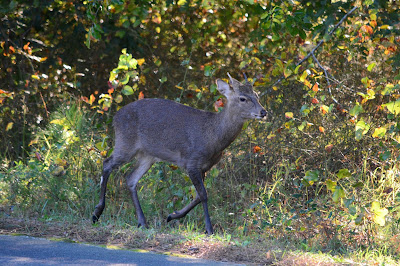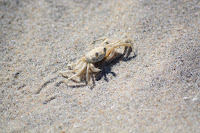I hope that you enjoy this post even though it isn't about removing trash from the environment nor were the photos taken in Eastern PA. It is about wildlife though, the main reason I go out and do clean-ups. On this trip I was able to see and photograph several species I had never come across before. The first was the immature Forester's Tern above. Several were sitting on the bridge to the National Wildlife Refuge.
This was the second mammal my friends and I came across in Chincoteague. We first saw White-Tailed Deer the night before. This is not a White-Tail and isn't even a species native to the United States. This is a Sika and is more closely related to our Elk than to Deer. Sika were released on the island a very long time ago and now have an established population here.
Like the Sika, Ponies are also an introduced species. From what I have read from the National Parks Service, it is unknown when the Ponies actually arrived on the island, but it was hundreds of years ago. The population on Chincoteague is monitored and managed, keeping the population between 150 and 160 individuals. Once a year all of the ponies are rounded up and some are sold as a way to control the population size. On nearby Assateague island, a separate population of about the same size is managed differently and ponies are given a form of birth control.
These were two common sights along the roadway in the refuge. On the left is a Great Blue Heron and on the right is a Snowy Egret. I wonder if any of the Great Blue's I saw were ones I have passed on Pennsylvania rivers?
For this photo you may have to click to enlarge. Near the center is a Magnolia Warbler. This was another bird I got to add to my life list.
On the ocean's edge Sanderlings were a common sight. This individual was foraging for food in the surf.
Very hard to spot, on and around the dunes there were many Ghost Crabs. For me they were impossible to see until they started moving. In the tidal areas I did also see Fidler Crabs, no good photos of those though.
I was pretty sure I would see bird species I had never seen before on this trip, but I didn't think I would see a new butterfly species. This is a Common Buckeye and there were lots of them in the refuge. What amazing coloration and eye spots!
A Semipalmated Plover, another new species for me. It was hanging around a couple Piping Plovers.
This Turkey Vulture ignored me as it flew in to some bones on the beach. I often see these in PA, I still thought it was neat seeing it feeding on the sand.
This was not the first time I had seen American Oystercatchers. They were still awesome to see again.
A group of Dunlin flying to feast on critters in the newly exposed sand from the tide going out.
This is something that I associate with manmade farm fields and quarries. Snow Geese to me just seemed out of place on the bayside. This is where their natural migration route takes them though.
From a distance I thought there were just two Black Backed Gulls on this pier. As I got closer I realized they were not gulls, but Bald Eagles!
When the tide went out I was able to see a few invertebrates that were exposed by the lower water. I can not say much about them, on the left is a species of saltwater snail and on the right a species of tube worm. The Tube worms had really cool tubes crafted out of shells and aquatic vegetation.
The bird near the center is a Piping Plover. According to the US Fish and Wildlife Service in 1986 with only 790 breeding pairs on the Atlantic Coast the Piping Plover was placed on the Endangered Species List. Since then efforts to help increase their populations have worked and the number of breeding pairs is double that of thirty years ago. Their status has been reduced to Threatened, but their numbers are still no where near what they once were.
I tried very hard to get a good photo of a Delmarva Fox Squirrel. That did not happen and this was the best I could do. The Delmarva Fox Squirrel is a subspecies of the Fox Squirrel and only occurs on the Delmarva Peninsula. According to the US Fish and Wildlife Service until recent years it made our nations list of Endangered Species. Due to recovery projects this subspecies rebounded to the point it was completely delisted. Still it is only found in abundance in specific places on the peninsula and does not have a widespread range.
This isn't a Fox Squirrel, I still think it's cool though. This black Grey Squirrel was on the Island Nature Trail in a township owned park. This is only the second black Grey Squirrel I have ever seen.
In the same township park I got to see another new species for me. This is a Brown-headed Nuthatch. This was our third stop to try to see this species and I am glad it was there.
My last view of the Wild Ponies before leaving. This was the most I saw in one place on the entire trip.
Like this project? Like it on Facebook: Taking Out the Trash in Eastern PA


























No comments:
Post a Comment